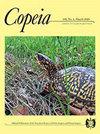美国东南部山合唱蛙(Pseudacris brachyphona)中隐藏的多样性和合唱蛙新种的诊断
IF 2.6
Q2 Agricultural and Biological Sciences
引用次数: 2
摘要
阿巴拉契亚山脉两栖动物多样性的一个主要驱动因素是该地区复杂的古地理。尽管人们对阿巴拉契亚山脉进行了广泛的研究,但其两栖动物门的大部分研究仍然鲜为人知。山蛙(Pseudacris brachyphona)是一种研究不足的生物,因为它难以捉摸,分布不均匀,繁殖季节短。系统发育研究表明短头海象内部存在不同的谱系;然而,采样不足和缺乏诊断形态学特征阻碍了对其分类地位的进一步评估。使用通过锚定杂交富集、声学数据和生态建模获得的全基因组核数据集,我们测试了短头海象中是否存在隐物种。我们的种树估计支持了以前基于线粒体的系统发育假说,这些假说将短头海龙属分为北部和南部分支。群体遗传聚类也显示出明显的遗传断裂,这与这些分支一致。在北方分支和另一种合唱蛙物种(P.feriarum)之间观察到混合物。对广告叫声的分析表明,与北方分支和其他颤音合唱蛙相比,南方分支的叫声发散、脉冲率更快、主频率更高。此外,物种分布模型表明,与北方分支相比,南方分支的栖息地适宜性包括松树为主和干燥的地区。鉴于分支之间的遗传、声学和生态差异,我们建议提高南部分支的分类地位,并将该新种命名为柯林氏山蛙(P.collisorum,新种)。新物种分布在阿拉巴马州北部,并延伸到佐治亚州、密西西比州东部和田纳西州南部。Pseudacris collisorum是一个新物种,在地理上与它的姊妹物种短头海狮(P.brachyphona)隔着田纳西河和周围的蓝岭悬崖。这项研究强调了全属、种群水平的遗传评估和综合数据集的必要性,以揭示无尾类的多样性。本文章由计算机程序翻译,如有差异,请以英文原文为准。
Hidden Diversity in the Mountain Chorus Frog (Pseudacris brachyphona) and the Diagnosis of a New Species of Chorus Frog in the Southeastern United States
A major driver generating amphibian diversity in the Appalachian Mountains is the complex paleogeography of the zone. Although the Appalachian Mountains have been widely studied, much of its amphibian phylogeography remains poorly known. The Mountain Chorus Frog (Pseudacris brachyphona) is one example of an understudied organism due to its elusiveness, patchy distribution, and short breeding seasons. Phylogenetic studies have suggested the existence of divergent lineages within P. brachyphona; however, insufficient sampling and the lack of diagnostic morphological traits have prevented further assessment of their taxonomic status. Using a genome-wide nuclear data set obtained via anchored hybrid enrichment, acoustic data, and ecological modeling, we tested for the existence of cryptic species within P. brachyphona. Our species tree estimation supports previous mitochondrial-based phylogenetic hypotheses that separate P. brachyphona into the Northern and Southern clades. Population genetic clustering also shows a sharp genetic break, which is concordant with these clades. Admixture was observed between the Northern clade and another chorus frog species (P. feriarum). Analysis of advertisement calls shows a divergent, faster pulse rate, and higher dominant frequency call for the Southern clade in comparison to the Northern clade and other trilling chorus frogs. Furthermore, species distribution models showed that habitat suitability for the Southern clade included pine-dominated and drier areas compared to the Northern clade. In light of the genetic, acoustic, and ecological divergence between the clades, we propose to elevate the taxonomic status of the Southern clade and name this new species the Collinses' Mountain Chorus Frog (P. collinsorum, new species). The new species ranges across northern Alabama, and extends into Georgia, eastern Mississippi, and southern Tennessee. Pseudacris collinsorum, new species, is geographically separated from its sister species, P. brachyphona, by the Tennessee River and surrounding Blue Ridge Escarpment. This study highlights the need for genus-wide, population-level genetic assessments and integrative data sets to uncover diversity within anurans.
求助全文
通过发布文献求助,成功后即可免费获取论文全文。
去求助
来源期刊

Copeia
生物-动物学
CiteScore
2.10
自引率
0.00%
发文量
0
审稿时长
6-12 weeks
期刊介绍:
Founded in 1913, Copeia is a highly respected international journal dedicated to the publication of high quality, original research papers on the behavior, conservation, ecology, genetics, morphology, evolution, physiology, systematics and taxonomy of extant and extinct fishes, amphibians, and reptiles. Copeia is published electronically and is available through BioOne. Articles are published online first, and print issues appear four times per year. In addition to research articles, Copeia publishes invited review papers, book reviews, and compiles virtual issues on topics of interest drawn from papers previously published in the journal.
 求助内容:
求助内容: 应助结果提醒方式:
应助结果提醒方式:


